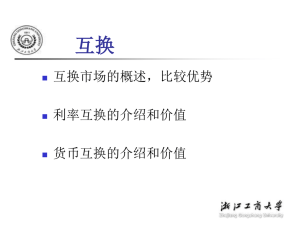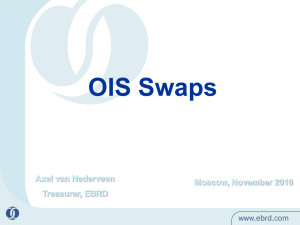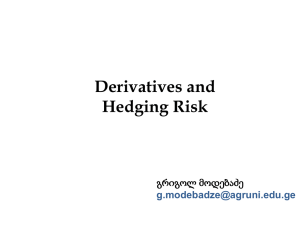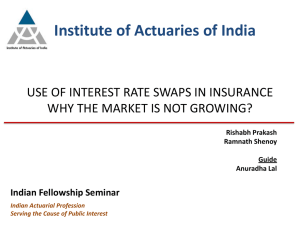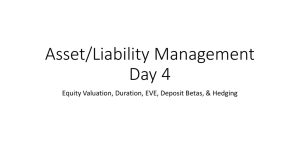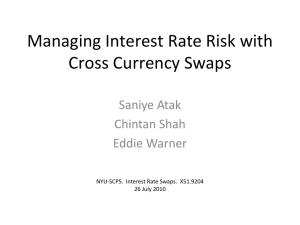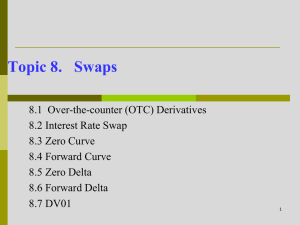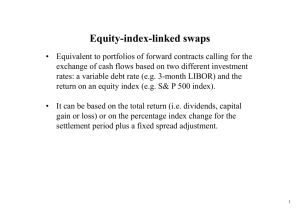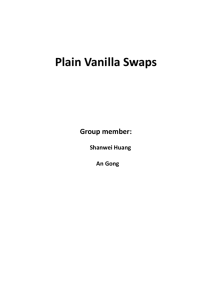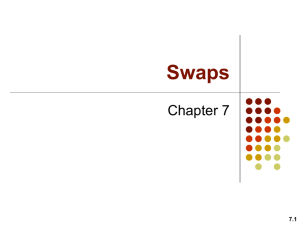Options & Futures
advertisement
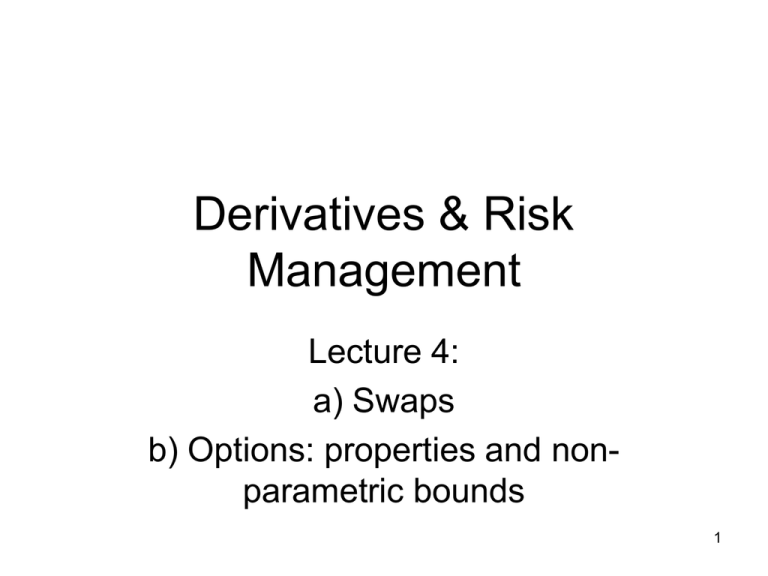
Derivatives & Risk Management Lecture 4: a) Swaps b) Options: properties and nonparametric bounds 1 Nature of Swaps • A swap is an agreement to exchange cash flows at specified future times according to certain specified rules 2 Example: a “Plain Vanilla” Interest Rate Swap • An agreement by “Company B” to receive 6-month LIBOR & pay a fixed rate of 5% per annum every 6 months for 3 years on a notional principal of $100 million 3 Cash Flows to Company B ---------Millions of Dollars--------LIBOR FLOATING FIXED Net Date Rate Cash FlowCash FlowCash Flow Mar.1, 1998 4.2% Sept. 1, 1998 4.8% +2.10 –2.50 –0.40 Mar.1, 1999 5.3% +2.40 –2.50 –0.10 Sept. 1, 1999 5.5% +2.65 –2.50 +0.15 Mar.1, 2000 5.6% +2.75 –2.50 +0.25 Sept. 1, 2000 5.9% +2.80 –2.50 +0.30 Mar.1, 2001 6.4% +2.95 –2.50 +0.45 4 Typical Uses for an Interest Rate Swap • Converting a liability from – fixed rate to floating rate – floating rate to fixed rate • Converting an investment from – fixed rate to floating rate – floating rate to fixed rate 5 A and B Transform a Liability 5% 5.2% A B LIBOR+0.8% LIBOR 6 Financial Institution is Involved 4.985% 5.015% 5.2% A F.I. B LIBOR+0.8% LIBOR LIBOR 7 A and B Transform an Asset 5% 4.7% A B LIBOR-0.25% LIBOR 8 Financial Institution is Involved 4.985% 5.015% 4.7% A F.I. B LIBOR-0.25% LIBOR LIBOR 9 The Comparative Advantage Argument • Company A wants to borrow floating • Company B wants to borrow fixed Fixed Floating Company A 10.00% 6-month LIBOR + 0.30% Company B 11.20% 6-month LIBOR + 1.00% 10 The Swap 9.95% 10% A B LIBOR+1% LIBOR 11 The Swap when a Financial Institution is Involved 9.93% 9.97% 10% A F.I. B LIBOR+1% LIBOR LIBOR 12 Criticism of the Comparative Advantage Argument • The 10.0% and 11.2% rates available to A and B in fixed rate markets are 5-year • The LIBOR+0.3% and LIBOR+1% rates available in the floating rate market are six-month rates • B’s fixed rate depends on the spread above LIBOR it borrows at in the future i.e. it is fixed only as long as its creditworthiness stays the same 13 Alternatives • Information asymmetry • Flexible and liquid instruments • Tax and regulatory arbitrage 14 Valuation of an Interest Rate Swap • Interest rate swaps can be valued as the difference between the value of a fixed-rate bond & the value of a floating-rate bond V B fix B fl 15 Valuation in Terms of Bonds • The fixed rate bond is valued in the usual way • The floating rate bond is valued by noting that it is worth par immediately after the next payment date 16 Valuation as bonds n B fix ke ri ti Qe rn t n i 1 B fl Q k e * r1t1 K* is the floating rate know from at the beginning of the period 17 Example • A financial institution pays 6 month LIBOR and receives 8% (semi-annually) on $100 million notional principal. • The FI has sold a floater and bought a fixed rate bond • remaining life 1.25 years • market rates for 3, 9, 15 months to go are 10%, 10.5% and 11% 18 Example II • The 6 month LIBOR when the swap was set up 3 months ago was 10.2%. 100 k 100 k * 0.102 1 2 * 5.1 19 Example III B fix 4e 3 0.10 12 4e 9 0.105 12 104e 15 0.11 12 $98.238 m illion B fl 105.1e 3 0.10 12 102.51 V 98.238 102 .51 4.272 20 Forward Rate Agreement • A forward rate agreement (FRA) is an agreement that a certain rate will apply to a certain principal during a certain future time period • An FRA is equivalent to an agreement where interest at a predetermined rate, RK is exchanged for interest at the market rate 21 Forward Rate Agreement continued (Page 100) • Capital R is the rate measured with compounding rate reflecting maturity, i.e. if the T2 – T1 is three months the rate is compounded quarterly etc. • The agreed cash flows are: • T1: - L • T2: L [1+ Rk (T2-T1)] 22 FRA • Note if Rf = Rk the FRA is worth 0. Why? • To value the FRA, we can compare now two payments at time T2: • One that pays Rk and one that pays Rf • Note: we are not assuming anything more than no arbitrage L 1+ R k (T2 -T1 ) -L 1+ R f (T2 -T1 ) e -r2T 2 = L R k -R f (T2 -T1 )e-r2T 2 23 Valuing future cash flows r1 rf r2 Xe rf T2 T1 Cash settlement X Hypothetical cash flow 24 Alternative Valuation of Interest Rate Swap: portfolio of FRA • Swaps can be valued as a portfolio of forward rate agreements (FRAs) • Each exchange of payments in an interest rate swap can be analyzed as an FRA • The relevant interest rates are the fixed for one leg, and the forward associated with the period to be valued for the other leg 25 Swaps as FRA’s • Suppose an interest rate swap promises fixed rate payments C and receives floating payments P1fl at regular intervals • We have seen that this could be valued as a portfolio of bonds • What about valuating it as a package of FRA’s? 26 Swaps as FRA’s II C P1 t fl T1 P2 T2 C C C fl P3 T3 fl P4 fl T4 27 Swaps as FRA’s III • Consider the second exchange of payments (the first is known) P 2 fl C • The floating rate payment is computed based on the prevailing spot rate at T1 28 Swaps as FRA’s IV r1 C 100 c R1,2 P2 r2 t T1 fl ~ 100 R1, 2 T2 29 Swaps as FRA’s V • So we want to compute the PV of ~ 100 R1, 2 c • Which can be written as ~ 100 1 R1, 2 100 1 c 30 Swaps V • The value of the fixed part of this payment is obvious v fix 1001 ce r2 T2 T1 • The value of the floating part less so because it involves a random interest rate v fl ~ PV 1001 R1, 2 31 Swaps as FRA’s VI • We know that at T2, the floating rate payment will be worth v fl ,T2 ~ 100 1 R1, 2 • And thus T1, it must be worth v fl ,T1 ~ 100 1 R1, 2 100 ~ 1 R1, 2 32 Swaps as FRA’s VII • And thus at time t it must be worth r1T1 v fl 100e • Recall that by no arbitrage r2T2 rT 1 1 rf T2 T1 • So that rT 1 1 r2T2 rf T2 T1 33 Swaps as FRA’s VIII • Hence v fl 100e r2T2 r f T2 T1 100e r f T2 T1 e r2T2 Changing compounding convention 100 1 R f e r2T2 34 Swaps as FRA PV 100 R1,2 c 100 1 RF e 100 1 c e r2T2 100 RF c e r2T2 r2T2 So to value a fixed for floating exchange, compute the present value of the exchange between the forward rate and the fixed rate 35 An Example of a Currency Swap An agreement to pay 11% on a sterling principal of £10,000,000 & receive 8% on a US$ principal of $15,000,000 every year for 5 years 36 Exchange of Principal • In an interest rate swap the principal is not exchanged • In a currency swap the principal is exchanged at the beginning & the end of the swap 37 The Cash Flows Dollars Pounds $ £ Years ------millions-----0 –15.00 +10.00 +1.20 –1.10 1 2 +1.20 –1.10 3 +1.20 –1.10 4 +1.20 –1.10 5 +16.20 -11.10 38 Typical Uses of a Currency Swap • Conversion from a liability in one currency to a liability in another currency • Conversion from an investment in one currency to an investment in another currency 39 Comparative Advantage Arguments for Currency Swaps • Company A wants to borrow AUD • Company B wants to borrow USD USD Company A AUD 5.0% 12.6% Company B 7.0% 13.0% 40 Valuation of Currency Swaps • Like interest rate swaps, currency swaps can be valued either as the difference between 2 bonds or as a portfolio of forward contracts 41 Swaps & Forwards (continued) • The value of the swap is the sum of the values of the forward contracts underlying the swap • Swaps are normally “at the money” initially – This means that it costs NOTHING to enter into a swap – It does NOT mean that each forward contract underlying a swap is “at the money” initially 42 Credit Risk • A swap is worth zero to a company initially • At a future time its value is liable to be either positive or negative • The company has credit risk exposure only when its value is positive 43
